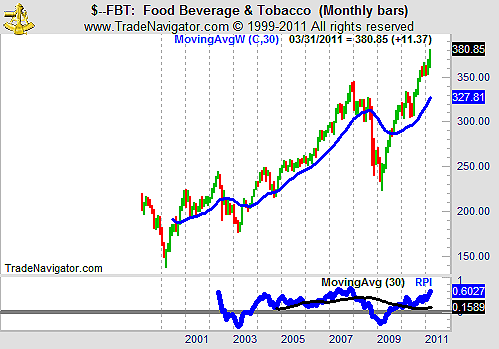
HOT TOPICS LIST
- MACD
- Fibonacci
- RSI
- Gann
- ADXR
- Stochastics
- Volume
- Triangles
- Futures
- Cycles
- Volatility
- ZIGZAG
- MESA
- Retracement
- Aroon
INDICATORS LIST
LIST OF TOPICS
PRINT THIS ARTICLE
by Mike Carr, CMT
It's a common belief that taking a risk in the markets is rewarded with higher returns. Like many market beliefs, however, this one may not stand up to scrutiny.
Position: N/A
Mike Carr, CMT
Mike Carr, CMT, is a member of the Market Technicians Association, and editor of the MTA's newsletter, Technically Speaking. He is also the author of "Smarter Investing in Any Economy: The Definitive Guide to Relative Strength Investing," and "Conquering the Divide: How to Use Economic Indicators to Catch Stock Market Trends."
PRINT THIS ARTICLE
STRATEGIES
Risk And Rewards
04/06/11 08:06:55 AMby Mike Carr, CMT
It's a common belief that taking a risk in the markets is rewarded with higher returns. Like many market beliefs, however, this one may not stand up to scrutiny.
Position: N/A
| Academic theory has long held that investors demand greater potential returns in exchange for taking on more risk. Traders generally act as if they believe this too, and they often look at riskier stocks as they seek out the potentially biggest gainers. This makes tech stocks a favorite of traders. |
| Over the long term, this relationship between risk and reward seems to break down. Many data providers offer a variety of sector indexes. For this article, we will use the sectors maintained by Genesis Trade Navigator. We have found that over the past five years, the food, beverage, & tobacco sector has been the most profitable, measured by the percent gain in the index over that time. This is consistent with how traders think of rewards, which are generally just considered to be gains. The monthly chart of this index is shown in Figure 1. |

|
| FIGURE 1: $FBT, MONTHLY. This index has delivered the largest gain of any sector over the past five years, showing a gain of more than 48%. |
| Graphic provided by: Trade Navigator. |
| |
| The technology & hardware sector gained only about half as much over that time frame, and the software sector only gained about a third as much as the food, beverage, & tobacco index. |
| We've endured a deep bear market in the past five years. While there are many ways to measure risk, one of the most practical seems to be drawdown. This represents the real-world measure of how much money is lost from a prior peak. Losses are the risk of trading, and despite a multitude of mathematical tools to precisely define risk, this simple tool represents the reality of trading pretty well. |
| By this measure, food, beverage, & tobacco offered the least risk. Over the past five years, the maximum drawdown was about 35% in the 2008-09 bear market. Hardware fell by almost 55%, as did the software sector. Tech, in this example, delivered lower returns and higher drawdowns -- more risk for less reward. Traders need to carefully consider risk when evaluating trade options. Seemingly boring stocks may have lower risk and offer significant potential, which could make them a valuable addition to a portfolio. Low-volatility, almost boring, long-term holdings could be combined with high-volatility positions in short-term trades to create a portfolio with higher potential returns and less risk than seen in a traditional trade plan. |
Mike Carr, CMT, is a member of the Market Technicians Association, and editor of the MTA's newsletter, Technically Speaking. He is also the author of "Smarter Investing in Any Economy: The Definitive Guide to Relative Strength Investing," and "Conquering the Divide: How to Use Economic Indicators to Catch Stock Market Trends."
| Website: | www.moneynews.com/blogs/MichaelCarr/id-73 |
| E-mail address: | marketstrategist@gmail.com |
Click here for more information about our publications!
PRINT THIS ARTICLE

|

Request Information From Our Sponsors
- StockCharts.com, Inc.
- Candle Patterns
- Candlestick Charting Explained
- Intermarket Technical Analysis
- John Murphy on Chart Analysis
- John Murphy's Chart Pattern Recognition
- John Murphy's Market Message
- MurphyExplainsMarketAnalysis-Intermarket Analysis
- MurphyExplainsMarketAnalysis-Visual Analysis
- StockCharts.com
- Technical Analysis of the Financial Markets
- The Visual Investor
- VectorVest, Inc.
- Executive Premier Workshop
- One-Day Options Course
- OptionsPro
- Retirement Income Workshop
- Sure-Fire Trading Systems (VectorVest, Inc.)
- Trading as a Business Workshop
- VectorVest 7 EOD
- VectorVest 7 RealTime/IntraDay
- VectorVest AutoTester
- VectorVest Educational Services
- VectorVest OnLine
- VectorVest Options Analyzer
- VectorVest ProGraphics v6.0
- VectorVest ProTrader 7
- VectorVest RealTime Derby Tool
- VectorVest Simulator
- VectorVest Variator
- VectorVest Watchdog
